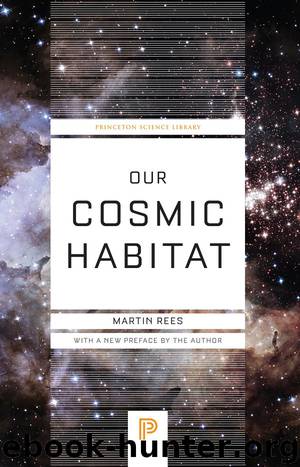Our Cosmic Habitat by Martin Rees

Author:Martin Rees [Rees, Martin]
Language: eng
Format: epub
ISBN: 9780691178097
Publisher: Princeton University Press
Published: 2001-01-15T07:00:00+00:00
PART II
The Beginning and the End
CHAPTER 7 Deceleration or Acceleration?
Limits to Prediction
In August 1999, a total solar eclipse was visible from southwest England. I viewed it from Cornwall through intermittent clouds. For me it was simply an environmental experience, shared with thousands of New Age cultists, astrology devotees, and the like. But the spectacle triggered some simple-minded thoughts.
It reminded me, first, that astronomy is by far the oldest quantitative science. Eclipses could be predicted, at least approximately, in the first millennium B.C. For several centuries, the Babylonians recorded celestial events on cuneiform tablets, and thousands of these records can now be seen in the British Museum. They stretched over a long enough timespan to reveal subtle patterns—particularly an eighteen-year repetitive cycle—which could be extrapolated forward to predict when future eclipses were likely to occur. Such predictions were feasible for lunar eclipses, which are observable from half the Earth’s surface, in contrast to solar eclipses, where “totality” occurs only along a narrow strip. Such predictions required no insight into how the Sun and Moon actually moved—only a faith in the regularity of nature.
It was not until the seventeenth century that substantial advances were made. By that time, astronomers such as Edmund Halley understood the layout of the solar system, and the eighteen-year cycle was realized to be due to a wobble in the plane of the Moon’s orbit. Halley is famous for his insight that the comet he saw in 1682 was the same one that others had also seen in 1531 and 1607. He did not live to see its predicted return on schedule in 1758, though he had the good luck to see two total eclipses of the Sun in England during his lifetime, and he had predicted them both. His predictions of the “totality strip” were better than the ancients could have made. But more important was a qualitative advance: Halley, unlike the Babylonians, based his predictions on the kind of insight that we could properly call a scientific explanation.
Such an explanation, of course, removes any mystery and irrational dread. For example, a few weeks after Europe experienced the August 1999 eclipse, major earthquakes occurred in Turkey and Greece; in earlier centuries it would have been natural to treat these as causally linked, whereas we now understand eclipses and earthquakes well enough to realize that a causal link is unlikely.
Eclipses are atypical among natural phenomena in being highly predictable: we can now forecast them to the nearest second. But earthquakes can’t be reliably predicted. Nor, of course, can the weather: when I went to Cornwall I didn’t know whether it would be clear or cloudy. This unpredictability does not reflect the greater competence of astronomers over seismologists and meteorologists: it illustrates the crucial distinction between prediction and understanding. Eclipse forecasts, even centuries in advance, are almost as accurate as the input data. But weather forecasts are not because atmospheric flow patterns are unstable: the uncertainty increases because even a tiny tweak can make a big difference to the outcome, as is the case when one balances a pencil on its end.
Download
This site does not store any files on its server. We only index and link to content provided by other sites. Please contact the content providers to delete copyright contents if any and email us, we'll remove relevant links or contents immediately.
| Aeronautics & Astronautics | Astronomy |
| Astrophysics & Space Science | Comets, Meteors & Asteroids |
| Cosmology | Mars |
| Solar System | Star-Gazing |
| Telescopes | UFOs |
Tools of Titans by Timothy Ferriss(8213)
Turbulence by E. J. Noyes(7935)
Secrets of Antigravity Propulsion: Tesla, UFOs, and Classified Aerospace Technology by Ph.D. Paul A. Laviolette(5309)
Astrophysics for People in a Hurry by Neil DeGrasse Tyson(5130)
Room 212 by Kate Stewart(5035)
Design of Trajectory Optimization Approach for Space Maneuver Vehicle Skip Entry Problems by Runqi Chai & Al Savvaris & Antonios Tsourdos & Senchun Chai(5011)
Pale Blue Dot by Carl Sagan(4907)
The David Icke Guide to the Global Conspiracy (and how to end it) by David Icke(4624)
A Journey Through Divination and Astronomy by Publishing Pottermore(4340)
Goodbye Paradise(3724)
Apollo 8 by Jeffrey Kluger(3635)
COSMOS by Carl Sagan(3553)
Losing the Nobel Prize by Brian Keating(3498)
The Five People You Meet in Heaven by Mitch Albom(3474)
How to Read Water: Clues and Patterns from Puddles to the Sea (Natural Navigation) by Tristan Gooley(3406)
Brief Answers to the Big Questions by Stephen Hawking(3369)
How to Read Nature by Tristan Gooley(3249)
The Order of Time by Carlo Rovelli(3144)
A Brief History of Time by Stephen Hawking(2959)
